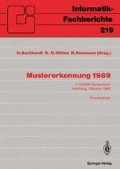Abstract
Wir stellen einen Ansatz zur Extraktion schmaler Adern in verrauschten medizinischen Einzelbildern vor. Es werden im wesentlichen Eigenschaften wie die nahezu konstante Aderdicke, die Parallelität und gleiche Steilheit der Ränder als Vorwissen benutzt. Obwohl an Verzweigungsstellen noch Erkennungsfehler auftreten, reicht die Auflösung außerhalb dieser Bereiche bis zu einer Aderbreite von 2-3 Bildpunkten. Der Algorithmus ist klinisch noch nicht erprobt und nicht als Produkt erhältlich.
Access this chapter
Tax calculation will be finalised at checkout
Purchases are for personal use only
Preview
Unable to display preview. Download preview PDF.
Literatur
Akita K., Kuga H., “A computer method for understanding ocular fundus images”, Pattern Recognition 15, 431–443 (1982)
Canny, “Finding Edges and Lines in Images”, Technical Report AITR 720 Massachusetts Institute of Technology (1983)
Catros J. Y., Mischler D., “An artificial intelligence approach for medical picture analysis”, Pattern Recognition Letters 8, 123–130 (1988)
Collorec R., Coatrieux J. L., “Vectorial tracking and directed contour finder for vascular network in digital subtraction angiography”, Pattern Recognition Letters 8, 353–358 (1988)
Haralick R. M. M., “Digital Step Edges from Zero Crossing of Second Directional Derivates”, IEEE Trans. on Pattern Analysis and Machine Intelligence, PAMI 6 (1984)
Hoffman K. R., Doi K., Chan H. P., Fencil L. Fujita H. and Muraki A., “Automated tracking of vascular tree in DSA images using a double-square-box region-of-search algorithm”, SPIE 626, Med XIV, PACSIV, 323–333 (1986)
Kruger R. A., Reinecke D. R.,Smith S. W. Ning R., “Recognition of blood vessels from x-ray subtraction projections: Limited Angel Geometrie, Med. Phys. 14, 940–949 (1987)
Nguyen T. V., Sklansky J, “A fast skeleton-finder for coronary arteries”, Proc 8th ICPR, Paris, 481–483 (1986)
Parker D. L., Pope D. L., Van Bree R. and Marshall H., “Three-dimensional reconstruction of moving arterial beds from digital subtraction angiography”, Comp. Biomed. Res 20, 166–185 (1987)
Rake S. T., Smith L. D. R., “The interpretation of x-ray angiograms using a blackboard control architecture”, Proceedings of the Int. Symposium CAR, 681–686 (1987)
Reiber J. H. C., Serruys P. W. and Slager C. J.,“Structural analysis of the coronary and retinal arterial tree”, In: Quantitative Coronary and Left Ventricular Cineangiography. Martinus Nijhoff, Dordrecht, 185–213 (1986)
Smets C., Verbeeck G., Suetens P., Oosterlinck A., “A knowledge-based system for the delineation of blood vessels on subtraction angiograms”, Pattern Recognition Letters 8, 113–121 (1988)
Stansfield S. A., “ANGY: A rule based expert system for automatic segmentation of coronary vessels from digital subtracted angiograms”, IEEE Pattern Anal. Mach. Intell. 8 (2), 188–189 (1986)
Stevenson D. J., Smith L. D. R. and Robinson G., “Working towards the automatic detection of blood vessels in X-ray angiograms”, Pattern Recognition Lettes 6, 107–112 (1987)
Suetens P., Haegemans A., Oosterlinck A., Gybels J., “An attempt to reconstruct the cerebral blood vessels from a lateral and a frontal angiogram”, Pattern Recognition 16, 517–524 (1983)
Suetens P., Oosterlinck A., Haegmans A., Gybels J., “Three-dimensional reconstruction of the blood vessels of the brain”, Proceedings of the ISMIII, Int. Symp. on Medical Imaging and Image Interpretation Berlin, 429–435 (1982)
Waidhas K, “Funktionalanalytische Untersuchung des GauBfilters bei Kantendetektionsverfahren”, Diplomarbeit am Mathematischen Institut der LMU, München (1989)
Author information
Authors and Affiliations
Editor information
Editors and Affiliations
Rights and permissions
Copyright information
© 1989 Springer-Verlag Berlin Heidelberg
About this paper
Cite this paper
Waidhas, K., Kutka, R. (1989). Adernextraktion durch iteratives Gradientenmatching in stark verrauschten medizinischen Bildern. In: Burkhardt, H., Höhne, K.H., Neumann, B. (eds) Mustererkennung 1989. Informatik-Fachberichte, vol 219. Springer, Berlin, Heidelberg. https://doi.org/10.1007/978-3-642-75102-8_28
Download citation
DOI: https://doi.org/10.1007/978-3-642-75102-8_28
Publisher Name: Springer, Berlin, Heidelberg
Print ISBN: 978-3-540-51748-1
Online ISBN: 978-3-642-75102-8
eBook Packages: Springer Book Archive

